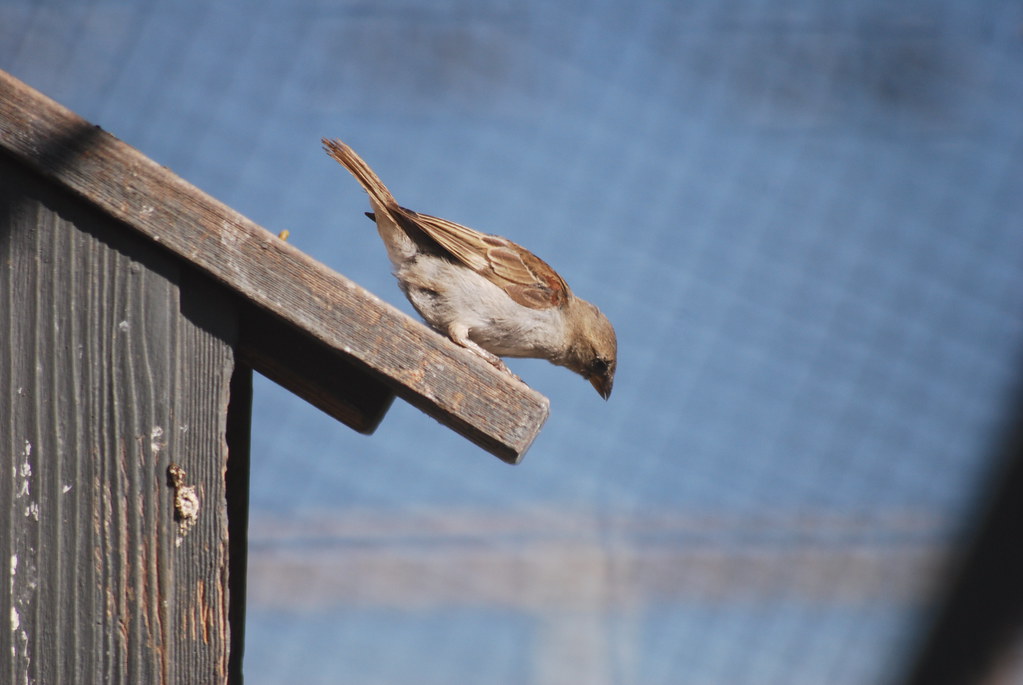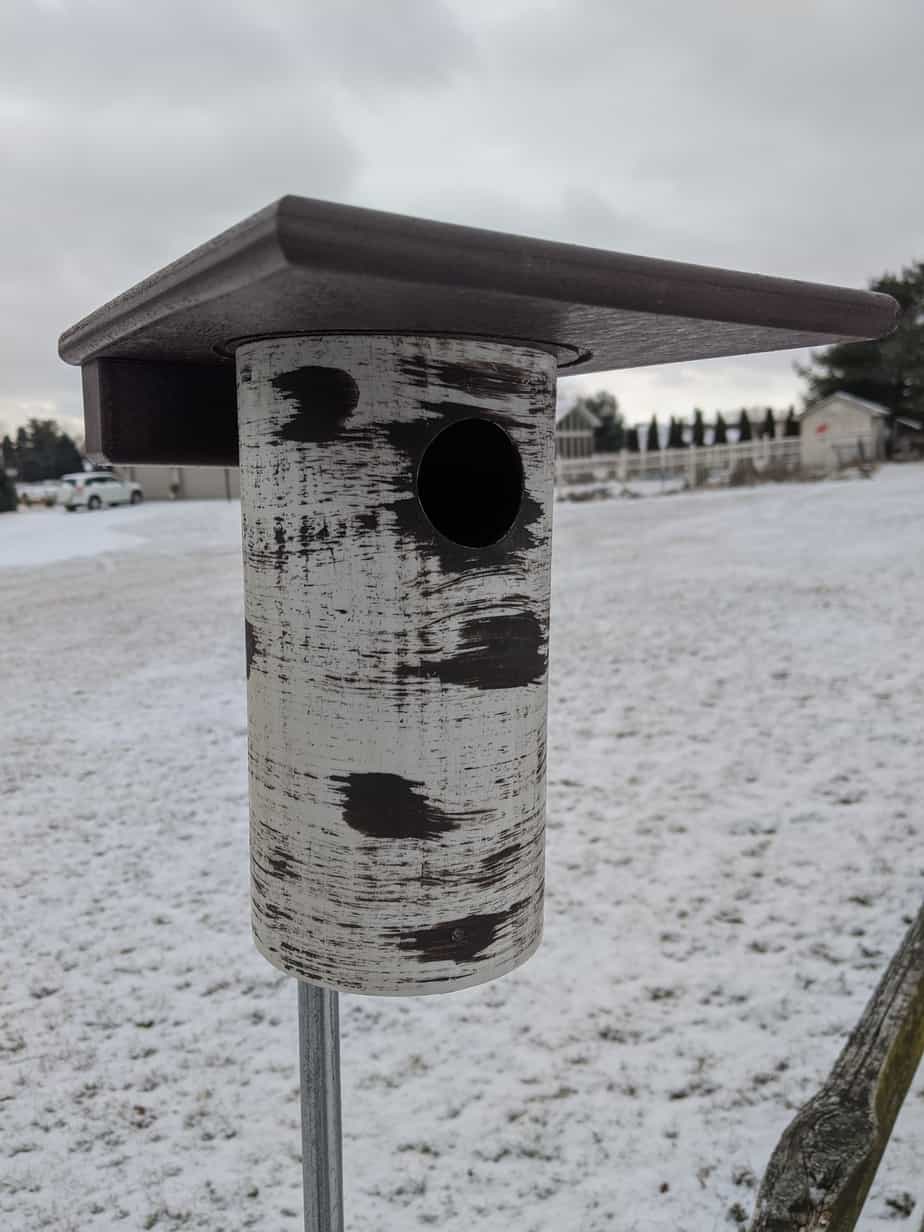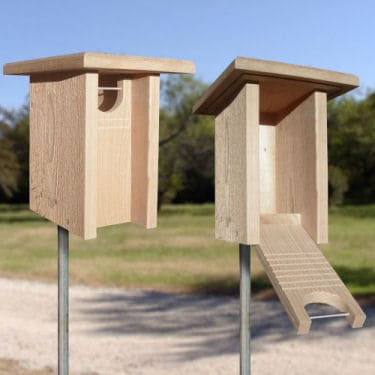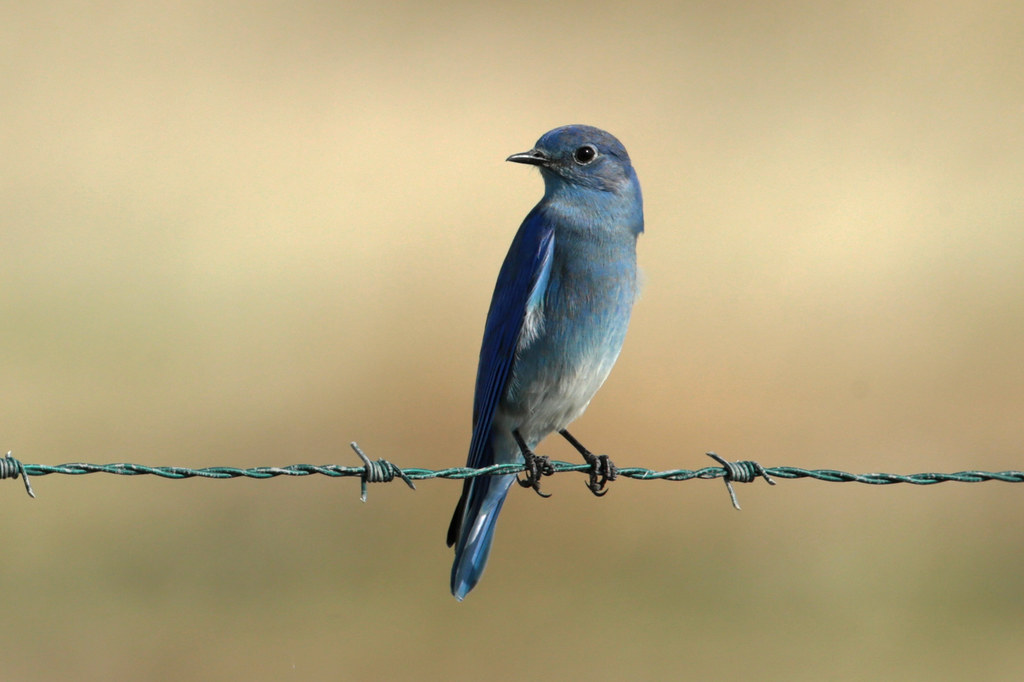
If you’ve been attracting bluebirds to your yard for any amount of time, you’ve likely run into issues with house sparrows. House sparrows are a territorial and aggressive, non-native bird species in North America and they compete heavily with bluebirds for nest boxes. Because of all the harm that house sparrows cause bluebirds, it’s normal to wonder about sparrow-resistant bluebird houses.
Photo above by THE Holy Hand Grenade! is licensed under CC BY-ND 2.0
Do sparrow-resistant bluebird houses exist?
While there aren’t any bluebird houses that are 100% sparrow-resistant, there are a few nest box designs that have been shown to deter house sparrows on some level. Gilbertson boxes, Gilwood boxes, and Troyer boxes (just to name a few) have all proven to be attractive to bluebirds and less attractive to house sparrows.
That’s the short answer. In this post, I’ll go over what it would take for a nest box to be truly “sparrow-resistant.” I’ll also cover some of the pros and cons of the major nest box designs that claim to deter house sparrows. Then I’ll give my opinion on the best nest box to use if you have issues with house sparrows in your yard or on your bluebird trail.
What you’ll find in this post:
- What it takes for a bluebird house to be truly “sparrow-resistant”
- Three “sparrow-resistant” nest box designs – the pros and cons of each
- The best “sparrow-resistant” bluebird house (My recommendation)
First, let’s talk about the idea of “sparrow-resistant” nest boxes.
What it takes for a bluebird house to be truly “sparrow-resistant”
For a nest box to be truly sparrow-resistant, it needs to have either of the following characteristics:
- An entrance hole that is too small for house sparrows to enter
- Some other feature that completely deters house sparrows from using the nest box
Let’s take a look at these two characteristics to see if it’s even possible for a bluebird house to fit the bill.
Entrance hole size: What would it take?

Since sparrows are smaller than bluebirds, if you were to design a nest box with an entrance hole that was too small for house sparrows to enter, unfortunately, the nest box would also exclude bluebirds.
For example, eastern bluebirds need an entrance hole that is at least 1 1/2 inches in diameter, while the smaller house sparrows can enter through holes as small as 1 3/16 inches in diameter. So, putting a small entrance hole on a nest box can’t be an effective strategy for creating a sparrow-resistant bluebird house.
In another article I wrote, I went through the proper entrance hole size for each species of bluebirds. I covered round entrance holes, oval holes, and slot entrances. Check that article out here.
Other features that could potentially deter house sparrows
Since entrance hole size alone can’t completely make a bluebird house “sparrow-resistant,” are there any features that work? While there aren’t yet any features that completely deter house sparrows from bluebird houses, horizontal slot entrances, shallow nest cavities, and nest boxes which allow light to enter the cavity have all been proven to deter house sparrows on some level.
None of these features mentioned above can completely keep house sparrows from entering or using a bluebird house, but they’ve been shown to be effective on some level at deterring house sparrows. So, if something seems to work, it’s worth trying!
If you want to attract bluebirds to your yard THIS YEAR, the best place to start is the Bluebird Landlord Audio Guide. In this audio guide, I’ll tell you everything you need to know about attracting bluebirds in just 59 minutes and 38 seconds.
Check out the Bluebird Landlord Audio Guide here.
3 “sparrow-resistant” nest box designs (the pros and cons of each)
#1. The Gilbertson Bluebird House

First on my list of sparrow-resistant bluebird houses is the Gilbertson PVC pipe-style bluebird house. These nest boxes are in the shape of a cylinder instead of a traditional box, they’re made out of PVC pipe, they have a relatively shallow nesting cavity (the distance from the entrance hole to the floor isn’t too deep), and they have a smaller total area in the nesting cavity as well (only 4″ in diameter). Each of these factors is helpful in deterring house sparrows.
The Pros
Gilbertson boxes seem to work against house sparrows for a few reasons. (1) The shallow drop from the entrance hole to the nest box floor and (2) the relatively small nesting cavity are unattractive to house sparrows. They seem to prefer larger boxes. (3) Sparrows also seem to not prefer the PVC pipe material that the nest box is made from. (source)
The Cons
Since Gilbertson nest boxes are on the smaller side, they work best for Eastern Bluebirds. The smaller nest cavity would not be preferable in mountain bluebird territory or in areas where mountain and western bluebirds overlap. In theory, you could design a larger PVC pipe-style nest box to suit mountain bluebirds, but this would then get rid of the smaller nest cavity, which seems to be one of the features that deters house sparrows in the first place. So, if you’re in mountain bluebird territory, another sparrow resistant nest box might work better for you.
Click here to see where you can get your own Gilbertson bluebird house on my Recommended Tools page.
#2. The Gilwood Bluebird House

Another nest box design that deters house sparrows is the Gilwood bluebird house. This nest box was designed by Steve Gilbertson, who also created the Gilbertson nest box mentioned above. The Gilwood nest box looks like a more traditional nest box made of wood, but it has an interesting oval-shaped hole that acts as the main sparrow-resistant feature of this bluebird house.
The Pros
The main pro with Gilwood boxes is the oval-shaped hole. The nest box features an extremely large entrance hole at the top of the box which allows sunlight to enter the nest box, even when birds are going in and out. Bluebirds seem to prefer light entering the nest box while house sparrows don’t (source). This is the biggest sparrow-resistant feature of this nest box.
And even though the oval entrance hole is large, starlings are not able to enter. A small wire that runs through the top of the entrance hole reduces the effective size of the hole, keeping starlings out, but allowing bluebirds and sunlight to enter freely. This in itself has to be one of the most ingenious nest box designs out there.
The Cons
While this nest box is highly attractive to bluebirds and much less attractive to house sparrows, it is a difficult nest box to build. It requires a little more advanced woodworking skills than other types of nest boxes. If you’re up for the task, check out the original Gilwood nest box plans from Steve Gilbertson here.
If you’re interesting in purchasing one of these nest boxes, sometimes you can find handmade Gilwood nest boxes online. Here’s a link to one that I found on Etsy. (If it doesn’t show up, just search for “Gilwood Nest Box” once you’re on the Etsy website and see what they have available.)
#3. The Troyer Bluebird House

The last of the three sparrow-resistant bluebird houses on my list is the Troyer Bluebird House. This is a wooden nest box with a slanted front, a smaller “cupped” nesting cavity, and a horizontal-slot entrance. Multiple features of this bluebird house make it resistant to house sparrows. Let’s look at the pros and cons of this style of nest box.
The Pros
The main sparrow-resistant feature of the Troyer nest box is the slot-shaped entrance. The horizontal-slot entrance at the top of the box allows light to enter the nest box, providing similar benefits to the Gilwood box. It’s also been shown that house sparrows prefer round entrance holes to horizontal slots, so this style is less attractive to them (source). The slanted front and smaller “cupped” nest cavity also seem to be disliked by house sparrows.
One of the other pros of the horizontal-slot entrance is that it allows bluebirds to escape if they are ever attacked by house sparrows inside of the nest box. When house sparrows trap bluebirds inside of their own nest box, they can usually win in a fight. However, when bluebirds spar against sparrows outside of the nest box, they have a better chance of defending themselves. When a sparrow tries to trap a bluebird inside of a Troyer nest box, they can more easily escape thanks to the horizontal-slot entrance.
The Cons
Similar to the Gilwood nest box, the Troyer bluebird house is more difficult to build than a traditional wooden nest box. The cup-shaped floor and the angled cuts make it more of an intermediate-to-advanced woodworking project. If you want to build one of these nest boxes yourself, go for it! Click here for the Troyer bluebird house plans.
But, if you’d rather purchase a Troyer bluebird house, I’m with you. There are a few good vendors that sell these nest boxes online. Click here to look at the Troyer bluebird houses sold by Purple Martin Products.
The best “sparrow-resistant” bluebird house (My recommendation)

For most cases, my top recommendation for sparrow-resistant bluebird houses is the Gilbertson PVC pipe-style nest box. This nest box has been shown over and over again to deter house sparrows and be attractive to bluebirds, specifically eastern bluebirds. I personally have used this type of nest box in areas where we’ve had persistent house sparrow problems. For eastern and western bluebirds, this would be my first choice. Click here to see where you can get your own Gilbertson bluebird house on my Recommended Tools page.
What about for mountain bluebirds?

Photo by Aaron Maizlish is licensed under CC BY-NC 2.0
There, unfortunately, are fewer sparrow-resistant bluebird houses designed with larger mountain bluebirds in mind. If you are in mountain bluebird territory, my recommendation is to build a mountain bluebird nest box with a 1 3/16 inch horizontal slot entrance instead of a round entrance hole. Click here for the NABS mountain bluebird nest box plans.
Doing this will provide mountain bluebirds with the space they need inside of the nest box but it will also offer the sparrow-deterring benefits of a horizontal-slot entrance.
Conclusion
So, while there aren’t any bluebird houses that are 100% sparrow-resistant, there are some great nest box designs out there that do a good job of deterring house sparrows. The Gilbertson style nest box, in particular, seems to be effective at attracting bluebirds and deterring sparrows.


